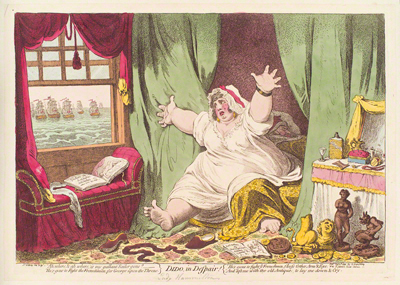Dido in Despair
The story of Dido and Aeneas had already been used by Gillray in Dido Forsaken (1787) to describe the way Mrs. Fitzherbert had been abandoned by The Prince of Wales during one of the crises brought about by the Prince's debts. Here Gillray uses it to caricature the despair of Lady Hamilton (Dido) as she looks out the window to see her lover Lord Nelson (Aeneas) departing with the Channel fleet to serve Britain in the Baltic.

© Trustees of the British Museum
Like Aeneas, Nelson had been seduced by the charms of a famously beautiful woman during an extended stay at her villa—in this case by Lady Hamilton whose aging husband was the British Minister at Naples. And in spite of the fact that both were married, neither Nelson nor Emma Hamilton made much effort to disguise their growing admiration for one another. When Sir William (thirty-five years his wife's senior) was recalled to England, he, Lady Hamilton and Nelson all traveled back to England together, taking a highly circuitous route home and exciting considerable scandalized remark along the way.
The timing of this print may have been prompted by the fact that the Hamiltons had arrived in England with the famous "'Hero of the Nile," as Nelson was popularly known, in November 1800 and had taken up residence in Picadilly as recently as January 6th. The trio were, as they say, "in the news." But the portrayal of Lady Hamilton as enormously fat may have had its source, apart from the caricaturist's love of incongruity and the lady's general proclivity towards plumpness, in the fact that she was nine months pregnant with twins. In fact, the only surviving child, a daughter significantly named Horatia, was born just a week before this print appeared (01/29/1801).
Though Gillray must have seen one of the more than sixty paintings and prints of Lady Hamilton by Romney, Reynolds, Lawrence, and Hopner, he seems to have made very little effort to create a convincing portrait caricature. Instead, like Hogarth, he uses a variety of significant objects in the room to identify and define his subject.
The open book beneath the window, for instance, is titled Studies of Academic Attitudes taken from the Life. This alludes to the early performance art or "Attitudes" in which Lady Hamilton, dressed in classical garb, would adopt a variety of poses portraying famous female figures from classical history and mythology, which Gillray later parodied in A New Edition Considerably Enlarged, of Attitudes Faithfully copied from Nature (1807).
Similarly, the book on the floor entitled Antiquities of Herculaneum Naples Caprea &c. &c. and the coins and statuary next to it allude to the archeological interests of her husband, Sir William Hamilton (significantly asleep behind her) who was famous for studies of Vesuvius and Aetna, and for his outstanding collection of Greek vases and other ancient artifacts.
But the specifics of the artifacts—including the illustration in the book, a laughing bust of Messalina infamous for her numerous sexual affairs, the statues of Venus and a satyr, and the coins or medals labeled after the love poet Ovid and Tiberius famous for his debaucheries—all suggest the illicit relationship of Nelson and Lady Hamilton. The broken status of Priapus, a god of fertility, may suggest both the result and the interruption of the affair.
If there were any doubts that the Aeneas in this fable was Lord Nelson, the subtitle would certainly have dispelled them. Nelson had famously lost an eye in the battle for Corsica in 1794 and an arm in the battle of Santa Cruz de Tenerife in 1797.
Ah, where, & ah where, is my gallant Sailor gone?
He's gone to Fight the Frenchmen, for George upon the Throne, He's gone to Fight ye Frenchmen, t'loose t'other Arm & Eye, And left me with the old Antiques, to lay me down, & Cry.
Foreshadowing Lady Hamilton's later path of decline when Nelson was indeed lost to her in 1805 after his famous victory at Trafalgar, we can see a jar of "Rouge a la Naples" on her vanity along with a "Composing Draught," and a flask of Maraschino liqueur.
Sources and Reading
- Commentary from the British Museum on Dido in Despair
- Draper Hill, The Satirical Etchings of James Gillray, 1976, #70
- "Horatio Nelson, 1st Viscount Nelson," Wikipedia
- "Emma, Lady Hamilton," Wikipedia
- Emma Hamilton Society
- Thomas Wright and R.H. Evans, Historical and Descriptive Account of the Caricatures of James Gillray #497
For more information about Lady Hamilton, see the Wikipedia articles on Sir William and Lady Hamilton and Horatio Nelson.
Comments & Corrections
NOTE: Comments and/or corrections are always appreciated. To make that easier, I have included a form below that you can use. I promise never to share any of the info provided without your express permission.